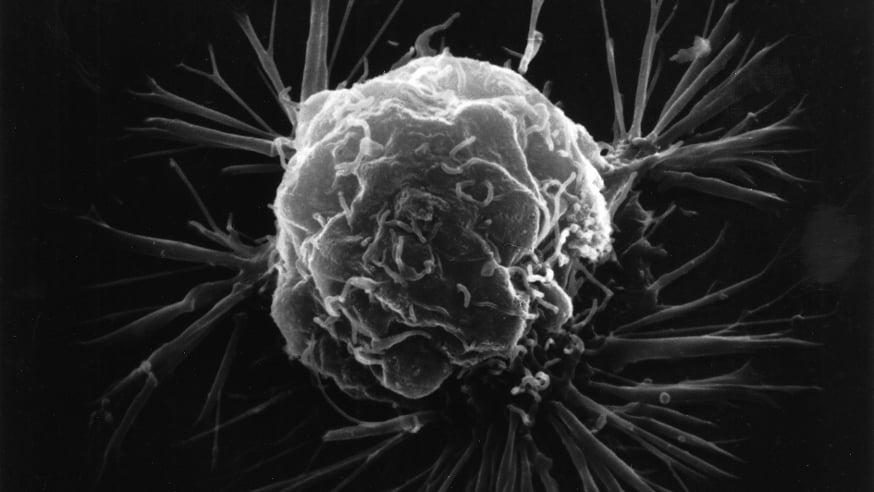
Breast cancer cell (photo: National Cancer Institute)
Scientists have discovered that non-cancer cells that wrap around blood vessels — called ‘pericytes’ — are helping breast cancer cells enter the bloodstream and spread around the body through the production of a key molecule called endosialin.
The study represents an important step forward in researchers’ understanding of how and why breast cancer spreads.
Currently, once the disease spreads to another part of the body — known as secondary (or metastatic) breast cancer — it becomes incurable and is ultimately the reason that around 11,500 women and 80 men lose their lives to the disease each year in the UK.
The research was led by scientists at the Breast Cancer Now Toby Robins Research Centre at The Institute of Cancer Research, London, and the German Cancer Research Centre (DKFZ) in Heidelberg. It was part-funded by Breast Cancer Now.
‘Spider-like cells’
Pericytes are large, spider-like cells that sit on the outside of blood vessels and support their growth and function. In a new study published today in the journal Cancer Research, scientists have identified the important role the production of endosialin on the pericyte cell surface plays in breast cancer spreading to other organs.
For breast tumours to grow, they need a blood supply and so they look to attract the growth of nearby blood vessels. As well as providing the cancer cells with the oxygen and nutrients they need, this blood supply also provides an escape route into the rest of the body — but it has not been clear up until now what mechanism could be helping tumour cells escape through the vessel wall into the blood.
Using a combination of studies in mice, cells grown in the lab and samples donated by breast cancer patients, the research team — led by Professor Clare Isacke in the Breast Cancer Now Research Centre at the ICR and Professor Hellmut Augustin at the DKFZ in Heidelberg — compared pericytes that produced endosialin with ones that couldn’t, and investigated how this affected the process of cancer spread.
Invading blood vessels
Having established in mice that a lack of endosialin prevented breast cancer cells from getting into the blood vessels, the researchers turned to lab experiments to understand how pericytes facilitated the invasion of cancer cells into blood vessels.
The researchers grew pericytes and endothelial cells — the cells that form blood vessels — in layers, to replicate the barrier that cancer cells have to cross to get into the bloodstream. They were able to show that far fewer breast cancer cells were able to migrate through these layers if the pericytes did not produce endosialin, and that the presence of endosialin was required for the pericytes to actively facilitate this mechanism.
Finally, the researchers investigated what clinical relevance endosialin could have. They split a set of 334 patient samples in half based on their levels of endosialin expression, finding that women with higher endosialin were significantly more likely to experience their cancer spreading to new sites than those with lower levels.
This research identifies endosialin as a potential biomarker in the future — testing patients’ tumours for the level of endosialin in the surrounding non-cancer cells could predict their risk of their disease spreading. By identifying those at high risk of spread, patients could be offered more intensive treatment.
Containing the spread of cancer
Furthermore, while this is early research, the scientists believe that endosialin could be a therapeutic target and that drugs that block its function might be useful to help prevent and contain the spread of breast cancer.
The next step for Professor Isacke’s team will be to try to uncover the exact mechanism by which pericytes begin producing endosialin, and precisely how endosialin helps cancer cells squeeze through the vessel wall into the blood.
Study co-leader Professor Clare Isacke, Professor of Molecular Cell Biology at the ICR, said: “Our study sheds valuable light on the role of pericytes — a type of cell that wraps around blood vessels — in helping breast cancer cells escape into the bloodstream and spread round the body. We found that a molecule called endosialin, which is produced on the surface of pericytes, plays a key role in aiding the getaway of cancer cells.
“We believe that endosialin could be a useful marker of how likely a woman’s breast cancer is to spread around the body. And it might even be possible to block cancer spread by targeting this molecule with new drugs – something we plan to explore in future studies.”
'Exciting' potential new drug target
Baroness Delyth Morgan, Chief Executive at Breast Cancer Now, said: “This discovery paves the way for research that could help prevent and contain the spread of breast cancer.
“We’re hopeful that this fundamental understanding could lead to new ways to identify patients at high risk of their breast cancer spreading, who could be offered more intensive treatment.
“That endosialin could also eventually be targeted by drugs to prevent and contain secondary breast cancer is a really exciting prospect.
“Secondary breast cancer, where the disease has spread, is ultimately the reason that around 11,500 women in the UK lose their lives to the disease each year. Uncovering the processes that allow tumours to spread is therefore one of the most crucial questions remaining in breast cancer research.”
The study was funded by Breast Cancer Now and the Medical Research Council in the United Kingdom, and the Deutsche Forschungsgemeinschaft and the Helmholtz Alliance in Germany. Breast Cancer Now thanked Walk the Walk and Future Dreams for their generous support towards Professor Isacke’s research.